British Electric
Locomotives
NB The sketches used for illustration are NOT scale drawings. I have to admit I have little information on the electric locomotives used by the railways, having been put off the modelling by the complexity of adding the associated overhead wiring or third rail. Alan Cox has been good enough to supply the information on the 1500v DC types used in Britain but I am deeply indebted to the members of the uk.railway and uk.rec.models.rail newsgroups who have provided a great deal of the information and, sadly, many corrections for the text.
Battery Powered Engines
The
first serious use of electricity for a standard gauge railway locomotive was a
battery powered loco built for the Edinburgh & Glasgow Railway in 1842 (I have not yet traced an illustration of the loco however), and battery powered engines have continued to be used into the present day, although rather rare. Both the Midland Railway and the North Staffordshire railway owned standard gauge battery operated 0-B-0 (0-4-0 in Whyte notation) engines (at least one each). These appear to be shunting engines, the MR got theirs (number 1550) in 1914, the NSR machine (an identical design) was built in 1917 and was retired in 1963. The sides and front of the bonnet sections are thick timber, probably lined with lead sheeting to protect it from spilt battery acid. The livery shown was taken from a photograph which was probably taken in the 1960s. The NSR tended to favour a rather minimalist livery on goods related stock, in earlier years it probably only had NSR on the left and the 'Staffordshire knot' on the right.
Fig___ NSR battery powered shunting engine
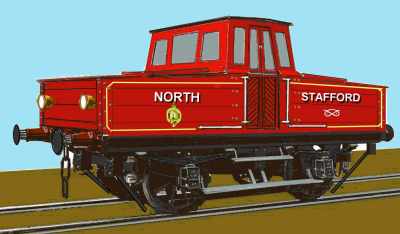
There is a good 'official' photograph of the MR engine on the Science and Society website (see Appendix Seven). The main differences being that the MR loco did not have the sand boxes and pipes, it had a big brass trumpet type horn on the cab front, mounted on one of the vertical supports and laying across the lower part of the centre window. The MR loco also used thinner buffer housings, the livery was (I believe) plain Midland Red (essentially the same as BR maroon) with MR on one side and 1550 on the other in white lettering about a foot high (this MR loco is illustrated in Appendix Four - Overview and General Information).
Also in 1917 the Lancashire and Yorkshire railway purchased what appears to be a similar battery engine in (used for shunting coal traffic at the Manchester power station, a 4mm scale kit is available from High Level Kits). This engine appears (from the kit) to have had a sheet metal body rather than the wood and metal of the MR and NSR engines. The photo below is courtesy High Level Models, this 4mm scale model still requires glazing and final painting.
Fig___ L & Y battery powered shunting engine
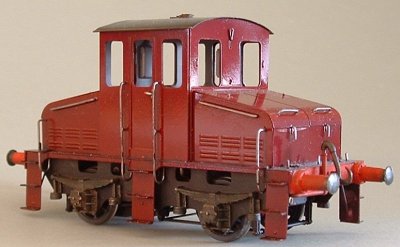
Building these small engines in N would be tricky, but in OO or larger scales they should represent no problem at all.
In the 1950s BR built a two-car battery powered electric multiple unit (BEMU), based Derby Lightweight DMU for use in Scotland.
Fig___ Gemini Battery Unit

Also in the 1950s BR rebuilt some Mk.1 brake coaches as 'Motor Luggage Vans' for use on boat trains. The sketch below shows the MLV in BR blue livery, the final London South East 'Jaffa Cake livery is shown in Appendix Four - Overview and General Information. These MLVs had a third rail pick-up but also a battery pack to enable them to operate on the quayside away from mains supplies and might therefore qualify as a locomotive (both these units are discussed in detail in Appendix Three - Electric Multiple Units).
BR Class 419 MLV
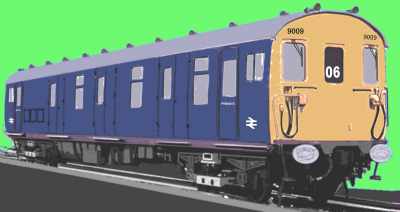
These days the only battery powered units I know of are the engineers trains used to service parts of the three rail system where London Underground train operate.
Early electric engines
In 1890 600v DC four-rail electric power was introduced on the London
Underground. The early London underground lines tried electric locomotive haulage, an example of one of the first engines is shown below. The sketch below was created based on photographs. The loco on the left is the City and South London Railway Locomotive No.1 (the first underground locomotive), built for a line that used a tunnel only about eight and a half feet in diameter. The loco on the right appears to be essentially similar (it may show the same loco at another time in its history). Even when they made the tunnels larger the underground or 'tube' lines have very restricted clearances, so the stock was (and remains to this day) rather squat, note the height of the figure beside the carriage, entry to which is via a vestibule and end door. In the photographs I have seen even the two man crew had to stoop when standing. There was no glass in the large side openings but I believe the end windows were glazed.
Fig___ Early London Underground Electric Locomotives
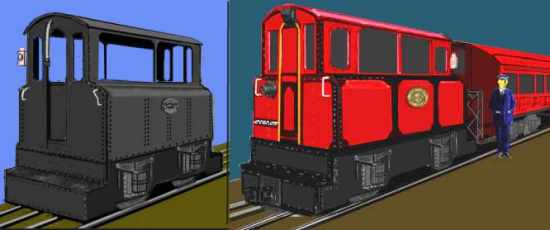
The colouring used for the livery is a complete guess, the photos I have seen are all black and white and low resolution. The sign on the lower left of the right hand loco is the destination board, sitting in a metal bracket, on the photo from which this sketch was made the destination was Moorgate. In the event there were numerous complaints about vibration, this was blamed on the locomotives and the various companies settled on lighter EMU type units for these all-underground lines.
In 1893 the 600v DC four-rail system was adopted for the Liverpool Overhead Railway (which remained in use until 1956). The Liverpool Overhead line (which ran along the bank of the Mersey, serving the extensive docks and associated offices) was always operated by multiple units but some of the London lines originally operated loco hauled services, at least one using centre-cab Bo-Bo locomotives. These locos were replaced by multiple units in the early years of the Twentieth Century (other than on the Metropolitan Railway as discussed below).
In 1903, faced with stiff competition from trams the NER decided to electrify is entire suburban network along the banks of the Tyne using third rail DC supply. Passenger services were operated by electric units (which I believe were single car units but able to operate in multiple). This proved a success and in 1904 they electrified the line to the docks on the Tyne, in part because the steep gradients proved hard going for steam engines but also because the crews found it hard going in the long tunnels. They built two Bo-Bo locomotives to handle traffic on the dock line, equipped with both third rail and overhead pickups (the latter for use in yards where a third rail would be dangerous). The original overhead current collection tackle was a curious hybrid design with a hoop type bow collector mounted atop a pair of hinged poles mounted on the bonnet (illustrated in Appendix Four - Overview and General Information). This was soon replaced with a roof mounted double-diamond pantograph as shown in the sketch below. These early dual pick-up locomotives remained in use into the mid 1960s.
Fig___ NER Electric Loco with third rail and overhead pick-up
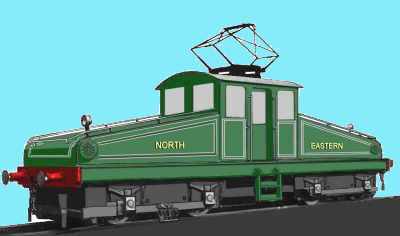
The passenger traffic on the Tyneside lines was, and remains, handled by electric multiple units. BR de-electrified the system in 1967 but the DMUs sent to work the lines proved less than satisfactory. In the event the suburban network was rebuilt as an overhead supply light rail system, the Tyne and Wear Metro. This system includes one of the three British underground networks (along with Glasgow and London) and has provided the basis for the development of light rail systems elsewhere in the country.
Third rail supply proved popular for commuter lines, in 1904 the Lancashire and Yorkshire Railway established a 630v dc third rail electrified line between Liverpool and Southport. This was the first 'main line' to receive electric supplies and in the early stages an experimental 2-4-2, or 1-B-1 locomotive was produced, equipped for both third rail and overhead pick up. The overhead gear was fitted front and rear and consisted of bow collectors consisting of twin booms with a cross-bar on the end, I believe that in use only the 'trailing' pickup would be raised to the wire.
Fig___ L & Y Electric Loco with third rail and overhead pick-up
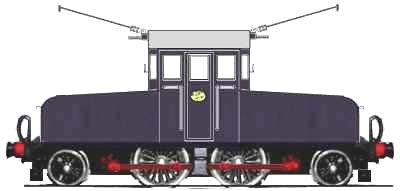
In practice multiple units were used for services on the line (discussed in the section on Multiple Units). The L & Y continued to develop and expand their electrified services, in 1906 the third rail reached Aintree (on the Preston line) and eventually reached Ormskirk in 1913.
At about the time of the First World War the North Eastern Railway introduced an overhead supply 1500v DC system. The NER had a set of ten Bo-Bo locomotives built in 1915 for Shildon to Newport services which ran on these lines. This proved a success, some sections of the original Stockton and Darlington railway had to be upgraded from two to four tracks to handle the heavy coal and iron ore trains hauled by the electric locomotives. Nick Leverton (on the uk.railway newsgroup) was able to advise that -
Only the one class of Bo-Bo was used on the line, and they always had
two pantographs. When the line closed in 1953, all the locos went into store
at Darlington. One example was rebuilt for projected use on the
Woodhead route (and classed EB1 - Electric Banking). During the
rebuilding this locomotive was given a single pantograph. It was
originally planned to rebuild the whole class, but delays and changed
plans meant that this was not done. The rebuilt loco was sent to South
Gosforth for storage, along with the rest of the locos. It then went
to Ilford carriage depot, for shunting purposes. It never worked on
the Woodhead route. The other nine locos were sent for scrap from South Gosforth.
Fig___ NER Electric Loco, 1500v DC overhead pick-up
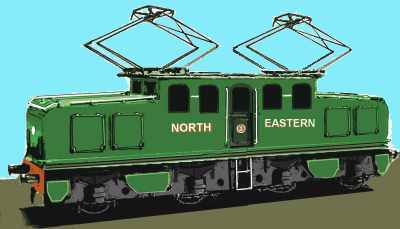
The sketch above shows the first engine delivered for this line, actually numbered Number 3, there followed a series of similar designs and even an experimental express passenger loco with a 2-C-2 (4-6-4 in Whyte notation) wheel arrangement which carried the number 13.
Mr Leverton went on to point out that -
The rather similar looking Westoe Colliery Railway (later NCB) Bo-Bo electric
locos were purpose built by a number of private builders from Siemens
in 1907 to EE/Bagguley in 1959. The centre-cab sloped-bonnets shape
was very common amongst early electric locos, not just the NER locos,
but AFAIK they were unrelated.
Fig___ Westoe Colliery Railway Loco with third rail and overhead pick-up
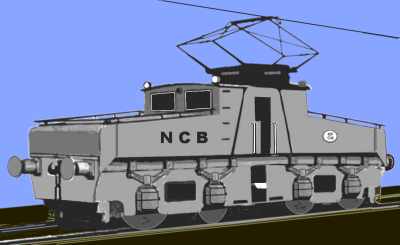
To supplement the third rail electric multiple units used for commuter traffic the Metropolitan Railway operated a fleet of Bo-Bo electric locomotives hauling conventional passenger carriages for its inner-London services (operated in shallow cut-and-cover underground lines within the city, running on the surface into the suburbs). In 1922 they purchased twenty replacement Bo-Bo locomotives with greater power, all these locos were named and one (Sarah Siddons, named after a famous actress) has been preserved. These engines had no internal bulkheads separating the cab from the control gear, so in summer the heat in the driving position must have made life uncomfortable, and the 'health and safety' side would today be a major issue.
Fig___ MET Electric Loco in London Transport livery
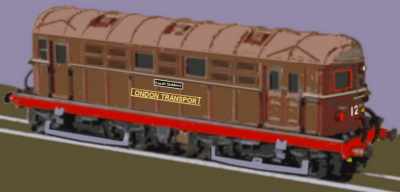
These engines worked trains out to Rickmansworth where the electric loco was exchanged for a steam engine. These electric loco hauled services ceased in 1961. The sketch shows such and engine in post 1933 London Transport livery. This was I believe originally London bus red but the preserved engine No. 12 Sarah Siddons is in milk chocolate brown lined in cream as shown here.
The 1500v DC
system had proved successful and was recommended by various committees over the
years as a national standard. It was used by the LNER/LMS joint operation on
the Cheshire Lines Committee (ex Manchester South Junction & Altrincham
Railway) line between Altrincham & Manchester in 1931 (discussed in the multiple unit section). In 1953 the line
between Manchester and Sheffield via the Woodhead tunnel was electrified at
1500v DC, but passenger traffic was withdrawn in 1970 and the line was closed
in 1981.
The decision to use the 25kV single phase AC system was taken by
British Railways in 1956 following pioneering work in France in the early
1950's.
The Lancaster-Morecombe-Heysham line (which had been electrified using 6.6kV AC 25Hz overhead supplies by the Midland Railway in 1908) was re-electrified at 6.6kV 50Hz and used for trials of AC equipment in 1959. It was on this line that the arm-and-elbow pantograph was developed. Subsequently the branch line between Manchester
Piccadilly station and Wilmslow, via Styal was kitted out with catenary wires and used as a test bed for the new 25kV WCML locomotives as they were delivered. The usual practice was to have one engine hauling another, travelling at some speed along the branch. The Styal line still has the banked curves where it joins the main line at the approach to Manchester Piccadilly station. This
line has now been further changed by the much delayed construction of the rail
link to Manchester Airport.
The 50Hz 25kV standard was actually a dual-standard as BR built EMUs and locos up to the Class 87 were equipped to run on either the full 25kV or a reduced voltage of 6.25kV. The lower voltage allowed for tighter clearances in tunnels and under bridges and was widely used in the London suburbs, the Glasgow area and other parts of the country. In practice the lower voltage ran into problems with the electrical gear used, in Glasgow and London EMUs encountered problems with transformers burning out (due I believe to switching transients). It was then found that the clearances on the full 25kV supply could be rather tighter than had been thought and the 6,25kV was gradually eliminated from the system. I believe the last 6.25kV line changed over to 25kV in 1983.
In 1960 the Crew-Manchester main line was
electrified and the new AL1 locomotives (later redesignated as Class 81) began hauling test trains and providing services. By 1967 the main lines between London, Manchester, Liverpool and
Birmingham were all electrified and by 1974 the wires reached Glasgow.
In
1973 the Class 87 was introduced for the West Coast line London-Glasgow run and in 1987 the BR
designed Class 90 was built as a replacement. The early series locomotives have continued in use for many years and I believe some Class 85, 86 and 87 locos remain in service in 2005.
Following the abandonment of the
British Advanced Passenger Train project the Brush Electrical Machine Co built
a Class 89 Co-Co loco which proved successful, but BR decided to go ahead with
it's own Class 91 design for the East Coast main line, although
this is rumoured to be less reliable.
In the large cities where extensive third rail services were already in place it was decided not to change over to the 'standard' 25 kV supplies, so third rail lines remain in operation in the North East, North West and London areas. These lines were mainly commuter oriented and employed electric multiple units so few locomotives have been built for third rail work since the 1930s.
A diesel electric type loco uses
about half as much fuel for a given load as a steam engine but can only supply
about half the power of a similar size electric locomotive. In a study
conducted in the 1980's British Rail concluded that an electric loco costs
about £1 per ton mile less than a diesel. The drawback is the heavy investment in infrastructure required for electric services.
Electric loco's
used by BR to date
DC types 1500v DC (LNER and the LMR of BR)
There were a number of single line electrification's at this voltage,
starting with a line in the North East, built by the
NER (discussed above). Various government bodies suggested that 1500v DC be adopted as the
national standard (as indeed it was in several countries on the continent, notably Holland) but the only major new British line to use the system was the trans pennine Woodhead line opened in 1953 (this line closed in 1981). In the event the success of the 25Kv AC experiments on
the Continent meant than no further 1500v DC lines were built and those which
remained in service were either closed or changed in the 1970's and 80's.
Tommy - No. 26000
The electrification of the Woodhead line using 1500v DC was planned in the 1930s but not completed until 1953. As part of this project a single locomotive named Tommy was delivered in 1941 and tested on 1500v but was never actually used for much. When the war ended in 1945 Tommy was shipped to Holland (where 1500v DC was in use) to help them recover from the extensive war damage. It returned to the UK in 1952 and was given the number '26000' but sadly it was sent for scrap in 1971.
EM1 later Class 76 Built in 1950 withdrawn in 1981 - Allocated to LMR.
Class 76 Bo-Bo (and 77 Co-Co) were based on 'Tommy'. They were among the first engines to feature
regenerative braking in which the motors are switched to act as generators, pushing power back into the overhead line (regenerative braking is now standard on British trains, improving energy efficiency on stop-start commuter lines by up to 20 percent). They were designed to handle the steep gradients on the trans pennine route and all were originally named (the names were removed in the 1970s when the line became freight only, mainly hauling coal for Wath power station). Some were equipped for multiple working with heavy loads of MGR wagons and these also had air brakes fitted.
Masterclass models offer a model of the Class 76 locomotive.
Fig___ Class 76
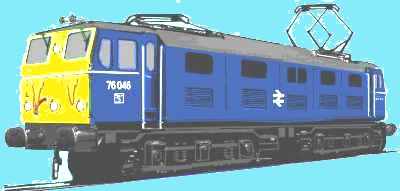
I believe the original colour scheme was BR 'mixed traffic' lined black, but I am not certain about that. I have seen a photo showing the engine in a plain green overall livery but that was a preserved example I believe. The example shown is in the final BR livery used before withdrawal. Not all engines had the multiple working jumper cables fitted, some had a very plain front with only the lights, handrail and vacuum brake pipe. In traffic it was normal to raise both pantographs. There is a cab section of an EM1 locomotive on display at Manchester Science Museum.
EM2 later Class 77 Built in 1954 withdrawn in 1981 - Allocated to LMR.
Class 77 was a small series of seven CO-CO locomotives originally called EM2s and all of which were named and used to pull passenger services, including ferry traffic bound for Harwich. They were fitted with two pantograph pick ups, one at each end, I believe that when in traffic both were used for current collection. Triang offered a model in OO but I am not aware of any other offering in RTR form. They were withdrawn in the 1970s following the end of passenger services. Six of these engines went on to work in Holland for many years. One survivor, ex 27001 "Ariadne", Dutch number 1505, was returned to the UK and is on display (in Dutch livery) at the Manchester Science Museum. EM2s number 27000 and 27003 are also preserved.
.
Fig___ Class 77 Co-Co Locomotive
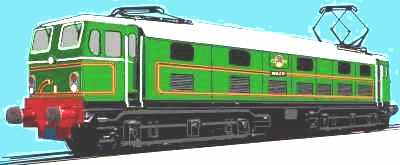
The sketch shows the loco in 'express passenger' lined green livery, later (in about 1960) an all over light blue with white roof scheme was applied to Class 77 engines (as shown for the Class 81 below) and these I believe had the rectangular yellow warning panel on the front. They retained the painted on roundel and bar logo as shown in the sketch.
From a discussion on the uk.railway newsgroup I understand that the coaches used on the Woodhead line electric hauled passenger services was mixture of BR Mark 1, LMS and LNER Gresley/Thompson and in addition some SR Bullied stock made it up from the Southern Region. In the later years the EM1 locomotives were used for the passenger services.
DC types 660v and 750v DC (Southern Railway & Southern
Region of British Railways)
The Southern Railway favoured
660v DC third-rail electrification for lines into London but most traffic was passengers, for which electric multiple units were built in large numbers. A number of electric locomotive designs entered service but these were built in small numbers. By the time of
Nationalisation the system was so extensive that it was considered too expensive to switch to the overhead systems then being considered, BR did however increase the voltage to 750v DC. Surprisingly, given the extent of the cut-and-cover tunnels in inner London steam remained a mainstay on the freight side, more recently freight has been handled by diesel locomotives and the small number of electric and electro-diesel engines available.
Class 70 Built in 1942, all withdrawn by
1969 - Allocated to SR
These were Co-Co locomotives using third rail pick-up but also fitted with a centre mounted pantograph for use in yards where simple overhead
wires (similar to tramway wires as only low speeds were involved) were fitted so staff could work in safety. They had a problem when running on third rail as they were shorter than a multi-coach EMU and sometimes the gap between the sections of third rail was too large. To get round this they were fitted with a motor generator set with a heavy flywheel, the current collected drove the motor, the generator supplied the engine and the flywheel kept things going over the gaps. The device was called a booster and the name stuck with the engines.
Fig___ Class 70 Co-Co Locomotive
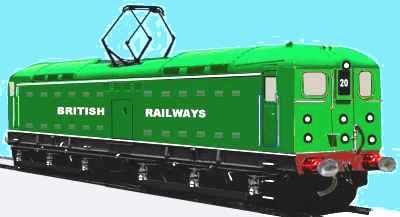
The sketch shows early nationalisation livery (the word SOUTHERN in yellow being replaced by BRITISH RAILWAYS in white). They lasted into the early 1970s and they ended up in rail blue with all yellow ends wrapped round as far as the doors on the sides with the number (E20001 in this case, they never received a tops number I believe) under the cab window and a single white double arrow somewhere about the centre. By this time most of the small vents on the side were plated over, although two of the larger vents in the upper side and the six above the cantrail remained.
Class 71 Built in 1959 and lasting until 1977 - Allocated to SR
These were
a Bo-Bo third rail design. Again the early examples had a single centrally
mounted pantograph for use in yards where overhead lines were installed. Some were subsequently fitted with an auxiliary diesel generator and became Class 74 (see below)
Fig___ Class 71 Bo-Bo Locomotive
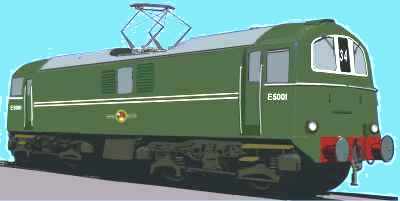
Class 73
Built in 1962, still in use in 2005 - Allocated to SR
These locos have a diesel auxiliary engine enabling them to operate on
un-powered track to allow inter regional working and operation during track
maintenance. They were built to fit the exceptionally narrow clearances on the line to Hastings. When that line was built the contractors made a rather poor job of building the tunnel on the line and this then had to be re-lined, reducing the clearances to below the standard loading gauge, as a result only specially modified stock could use the line. Up to 2000 the duties were shared with modified Class 33 diesels, but they were scrapped in that year.
Fig___ Class 73 Locomotive in Network South East livery
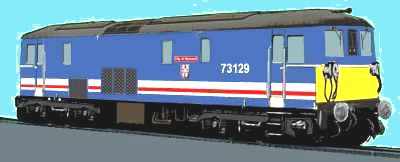
The livery shown in the sketch is taken from a photograph dated 2000, Network South East was established in June 1986. This loco did not carry the Network South East lettering only the coloured bars. At least one Class 73 (73101) has been painted in Pullman colours, white roof, dark brown body with cream band on the upper side and the word PULLMAN in gold above that. It still has the required yellow panel on the lower part of the front however as shown on the NSE livery above. I am not sure but I believe this has been done for the privately run Orient Express service operating from London. GB Railfreight have acquired a small number of Class 73s, painted in the standard blue livery with yellow ends and cab sides and letting in yellow. Unusually these engines have GBRaifreight on the sides in place of the usual GBRf.
A model of the Class 73 is available from Dapol in the Pullman livery.
Class 74 Built in 1967 and lasting until 1977 - Allocated to SR
These were
modified Class 71's fitted with an auxiliary diesel generator which allowed
them to operate on the Bournemouth line prior to the completion of
electrification. When operating on electrified lines the locomotive acted as 1600 b.h.p. electric unit and was diesel powered on non-electrified lines. These engines were often referred to as 'Amphibian' locomotives and were principally used for freight services. Forty three were built.
Fig___ Class 74 Locomotive
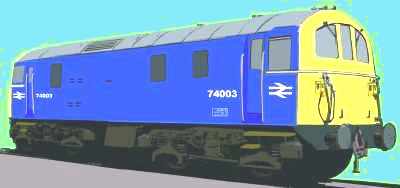
25kV AC types
Following a single prototype (E1000 based on the converted gas turbine engine 18100) there
were five classes of contractor-built 1st generation loco designs that entered service. Originally designated types AL1 to AL5,
they became Classes 81 to 85, all were broadly similar in appearance and known by enthusiasts as Growlers due to the noise of the original type of rectifiers used. Originally they were fitted with two pantographs but in
later years (starting in the later 1960s) one was removed as [part of a major rebuild incorporating new solid state rectifiers (the empty roof space being used for a rack of gas cylinders) and all subsequent designs have only one fitted.
Several pantograph designs have been developed for high speed 25kV working, the sketch below shows three types of pantograph used at one time or another on the AL series of engines. 'A' is a Stone-Faiveley single arm pantograph, as fitted in pairs to all the original AL1 to AL5 series engines and widely used on multiple units. is the GEC/AEI cross-arm type used on some of the 25kV ac locomotives. 'B' is the Faiveley design used on a number of multiple units and on some early locomotives (this had a substantial frame of one inch tubular metal and hence is sometimes called the 'bicycle frame type'). 'C' is the GEC/AEI cross-arm pantograph fitted to the last of the Class 86 locos (numbered E3055 it was destroyed by a fire before TOPS renumbering) and fitted as standard on all Class 87s (both the class 86s and 87s had only a single pantograph from new). 'D' is the BR/Brecknell, Willis Pantograph developed in the early 1970s, this became the standard for high speed locomotives in the UK (and in several other countries). This design of high speed pantograph was first used on the Class 87 engines geared to run at 110mph and subsequently has been widely used, retro fitted to older engines in the UK, fitted as standard on new engines and used by several other countries as well. Examples are shown on the sketches of the Class 86 and 87 locomotives below.
Fig___ 25kV pantograph designs

A single Class 82 or 83 may have been fitted with one cross-arm type and one Faiveley 'B' type for comparison purposes but I am not sure on that.
Over the years there appear to have been changes to the numbers of vents or windows in the upper sides of the early 'ac' electric locomotives and the two sides were often different. The Class 86 in particular appears to have a wide number of variants. For accuracy when modelling these engines it is necessary to find a photograph of the particular engine at the required point in history.
Class 80 Bo-Bo Built in 1958, withdrawn 1972 - Allocated to LMR
This class consisted of a prototype made by converting the experimental Metro Vic gas turbine engine 18100. The resulting machine was given the number E1000 (later changed to E2001) and became Class 80 under TOPS. It had a single pantograph fitted and operated on the line between Manchester and Wilmslow via Style which had been equipped for 25kV overhead trials.
Fig___ Class 80 (showing original black and silver livery)
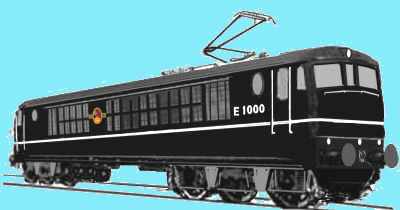
The body of the gas turbine engine was long enough to house all the equipment, so little was slung underneath the chassis. I believe it spent its entire working life in BR main line black and silver livery.
Class 81 Bo-Bo Built by AEI in 1959, last two units retired in 1991 - Allocated to LMR
Fig___ Class 81 (showing original light blue and white livery)
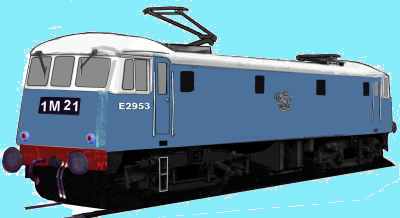
The sketch shows the original livery for this class of machine, the 'electric blue' body colour was lighter than the later Rail Blue adopted by BR, the cab surround and roof was white, the number (prefixed with an E) was added using bolt on cast metal letters and the BR logo (the Lion Rampant, or ferret and dartboard type) was also a cast metal attachment in plain silver. Name plates, when fitted, were cast metal, painted buffer beam red with silver raised edge and lettering.
Class 82 Bo-Bo Built by AEI in 1960 all withdrawn
by the end of 1987 - Allocated to LMR .
Fig___ Class 82
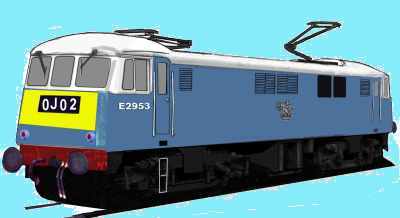
This loco is in early 1960s livery, still light blue and white but now incorporating the original small yellow warning panel on the front of the cab (the buffer beam is still red).
Class 83 Bo-Bo Built by English Electric in 1960 and
withdrawn 1987 - Allocated to LMR.
Fig___ Class 83 (showing BR 'corporate blue' livery with cast E number)
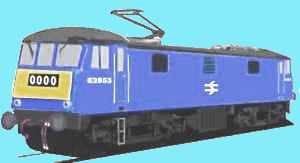
The sketch shows a locomotive on which the cast metal E number has not yet been replaced by a painted on 83xxx series number, in some cases this took many years.
The body is in post 1964 BR 'rail blue' with double arrow logo and the smaller yellow panel, the buffer beam is now black. The four character head code box has been set to read 0000 (standard practice after 1976, see also the section on Communications, Control and Signalling, Bell Codes &Locomotive Head Codes).
Class 84 Bo-Bo Built by GEC in 1960, all withdrawn by 1983 - Allocated to LMR
This class had distinctive deep ventilator grilles on one side of the body (the other side had a pair of windows at each end with two single windows spaced along the upper body side). In the photograph from which the livery was sketched there were no TOPS markings visible and no electrification warning flashes visible anywhere on the body. This would not normally be the case, I would expect to see warning flashes on either side of the front in the area of the hand grab rails.
Fig___ Class 84 (showing BR Corporate Blue livery)
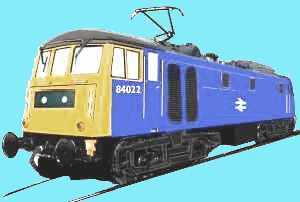
The body is in post 1964 BR 'rail blue' with double arrow logo and the front is all-over yellow but the four character head code box has a black plate inside with two holes for the internal lights to show through. The sketch shows a locomotive on which the cast metal E number has been replaced by a painted on 84xxx series number (this was done some time after 1973, probably in the early 1980s).
Class 85 Bo-Bo Introduced 1960 - Allocated to LMR
The 85s featured the new solid-state diode
rectifiers, subsequently retro fitted to all loco's. The class was often assigned to freight duties and the sketch shows the locomotive in the later 1980s wearing Railfreight triple grey livery with the Railfreight Distribution sector logo. It probably operated hauling trains of wagons in the all-air braked Speedlink network.
Fig___ Class 85
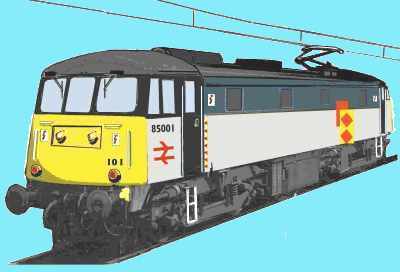
By this time the headcode panel had been plated over but two white light fittings were mounted on the plate itself. One odd point in this particular example is the lack of a high intensity white light mounted in the lower part of the front, by this time many locomotives had these fitted but the example in the photograph from which the livery was taken did not. Initially a simple 'spot lamp' was added, later a properly boxed in lamp appeared.
Class 86 Bo-Bo Introduced in
1966 - Allocated to LMR
These engines were developed for the Manchester/Liverpool-London West Coast Electrification. They started life in Corporate colours of rail blue and double-arrow logo but retained the cast metal E numbers on the cab sides well into the blue and yellow era. The sketch shows the changes during the run up to privatisation, the E number has been replaced by a painted on 86xxx number and this example was in post 1991 Rail Express Services livery. Res, as it was generally known, was the former parcels sector of British rail and dealt with both parcels and mail for the Royal Mail (formerly the GPO). This class was a regular on freight services, hauling everything from Freightliners to parcels stock. Nthusiast Resprays offer a model of the Class 86.
Fig___ Class 86 in Rail Express Services livery
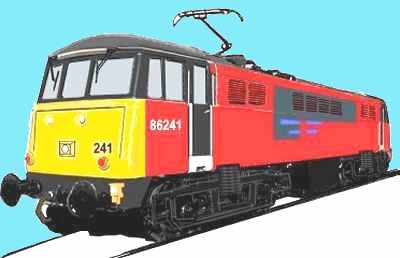
The 86s were delivered with a single Stone-Faiveley type pantograph, one was fitted with the GEC/AEI cross-arm pantograph
Class 87 Bo-Bo Introduced 1973 - Allocated to LMR
Used for the WCML passenger services with the completion of the
work as far as Glasgow. I believe these were the most successful type of this generation of locomotives. The sketch shows the 'Intercity' livery with the swallow logo adopted in the later 1970s and retained until privatisation (after which the swallow was removed and the word Intercity painted over pending re-livery by the new operating companies). Farish have released a model of the Class 87 in late 2005.
Fig___ Class 87 Locomotive
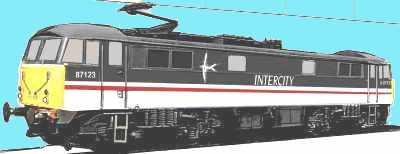
Class 88 was not used
Class 89 Co-Co
A private
venture by Brush intended to haul high speed passenger trains after the
abandonment of the British APT. Not taken up as a class by BR but the prototype unit was used for passenger traffic until the early 1990s, it was then withdrawn and sold to a preservation team but subsequently purchased for use on the ECML where it has remained in service with GNER operating alongside the Class 90s and 91s. The loco had a double ended body, with a nose shape reminiscent of the prototypes for the HST and employed advanced (for the time) control systems, some of which were incorporated in the Class 90 and 91 locomotives. This was the first 25kV locomotive to be fitted with Buckeye style knuckle couplers in place of the screw link type.
Fig___ Class 89 Locomotive
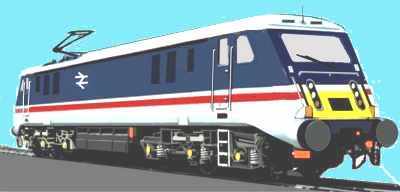
The sketch shows the as-delivered livery, usually called 'Intercity executive' livery. This was later replaced by the 'Swallow' Intercity livery and the engine now runs in GNER colours.
Class 90 Bo-Bo Introduced in
1987, entered service 1990
In 1987 BR 'sectorised' their business and locomotives were dedicated to specific classes of traffic, some of the main line electrics were assigned to freight duties but the Class 90s were at the time reserved for the high speed WCML passenger trains. In the event some of these locomotives were secured by Railfreight Distribution (the wagon load traffic branch of BR Railfreight) in the early 1990's and repainted in the triple grey colour scheme of the freight sectors with the RfD red diamonds logo. Farish plan to release a model of the Class 90 in late 2005.
Fig___ Class 90 Locomotive in Railfreight Distribution colours
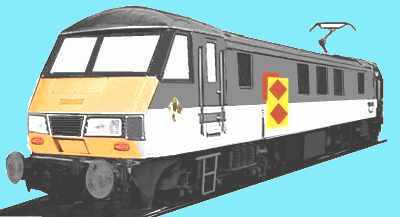
The specification called for the ability to work in Push-Pull mode at one end of a rake of Mk 4 coaches, see the Railcars and Multiple Units section for a photo of a Class 90 in EWS livery on such a job in 2005. Farish have released a model of the Class 90.
Class 91 Bo-Bo Introduced in 1988, entered service in 1989 or 1990
When the Advanced Passenger Train project ran into difficulties in the mid 1980s BR decided they needed something to work the future WCML and ECML high speed passenger trains. It was decided that a push-pull service would be preferable, with a loco at one end, a rake of purpose built coaches and a driving trailer at the other end (see also the section on Railcars and Multiple Units). The specification devised by BR required a 225kph top speed in passenger mode but also required the locomotive to work at night hauling Freightliner trains. In the event GEC got the contract to build the locomotives and coaching stock, subcontracting the construction work to BREL at Crewe. The first locomotive appeared in early 1998 but with delays in the coaching stock (upgraded Mk 4 coaches) old HST driving trailer coaches were used initially on the ECML services. Thirty one locos were built, numbered 91001 to 91031, following an upgrade program the modified locos are Class 91-1 and numbered 911xx. The loco has a pointed end and a blunt end, each with a cab, but works with the pointed end outwards on passenger services. Originally operated in Intercity livery they are now operated by GNER and provide the mainstay of express passenger services on the ECML, notably on the GNER 'Mallard' services. Farish have released a model of the Class 91 in late 2005. An OO model is available from Hornby.
Fig___ Class 91 Locomotive
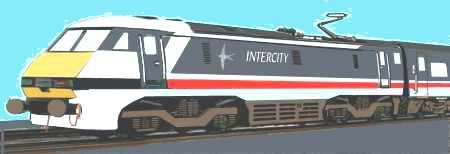
Class 92 Co-Co Introduced in 1994
This engine was developed specifically for freight work through the Channel Tunnel, and carried a three ring logo on the side indicating its connection with the tunnel. For working through the tunnel they have what amounts to two locomotives in a single body, everything being duplicated for safety reasons. In addition they can operate either on 25kV overhead supplies or the 750v DC third rail system employed in the London area (although when running on 750v they have a lower power rating). The actual body was based on the successful Brush Class 60 diesel locomotive but with extensive modification to the internal structure of the cab fronts to meet European crash protection rules. They closely resemble the Class 60s but lack the large open grille on the side (they have two, smaller, and less transparent grilles instead). The Class 92s are cleared for use on the WCML but cannot wander about in France as they lack the French in-cab signalling systems. The locomotives were originally owned by BR (Railfreight), SNCF (the French nationalised railways) and Eurotunnel (now called Eurostar Ltd), I believe they are all based in the UK at Crewe. The Eurostar engines were intended for night sleeper services however when this idea was dropped they were purchased by EWS for freight work alongside the former BR owned engines. Standard livery was the BR Railfreight triple-grey scheme, each of the operators having a logo displayed on the cab side only, BR had their double arrow in the form of a bolt-on metal plate at one end with the diamond shaped Crewe depot plate on the other cab side.
Fig___ Class 92 Locomotive
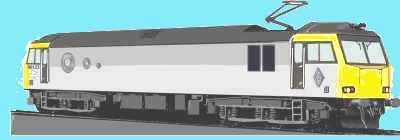
EWS have now repainted at least some of these engines in their maroon and gold house colours, others are (in 2005) still in Railfreight grey but with a rectangular maroon patch toward the right hand end bearing the EWS company initials above the three-head logo in yellow. In all cases the three ring Chunnel logo has been retained (this consists of metal rings bolted to the body shell). I have seen both liveries on engines passing through Stockport just South of Manchester.
^
Go to top of page
International Good Guys ~ Making the world a
better place since 1971 ~ Site maintained by

All material Copyright © Mike
Smith 2003 unless otherwise credited




























